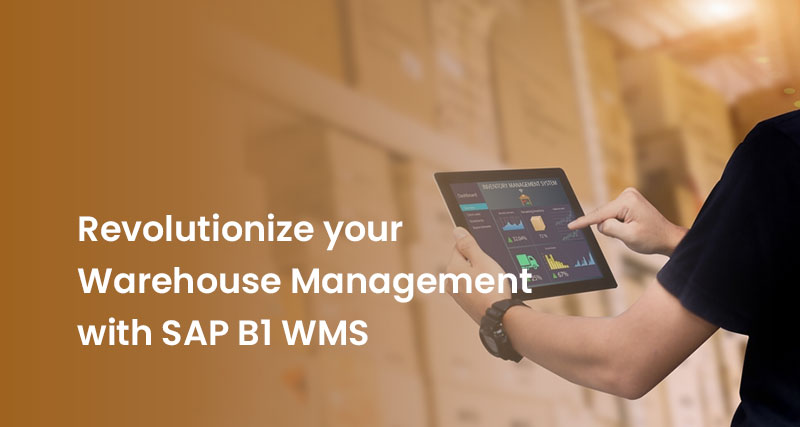
Revolutionize your Warehouse Management with SAP B1 WMS
What if the company keeps on producing the product but does not realize that the demand in the market is fewer? In this scenario, the products get stocked up in the storage and after some time the inventory is bottled up. What next? The manufactured products get wasted and have to be washed out, and the manufacturer has to bear the loss. To prevent this situation in an organization, a Warehouse Management system was brought up. But what is a warehouse? Why do companies need to maintain a warehouse? Let’s get to this in detail.
Any stakeholder of the supply chain can maintain the warehouse, may it be the manufacturer, retailer, wholesaler, distributor, or even the customers, in order to store goods. Process of warehouse management: first the raw materials are procured, then manufactured in the units and passed to finished goods, and later distributed to the customers. The warehouse is a storage that is used for raw materials, semi-finished goods, and finished goods. There are various strategies on how to choose the material, where the system should search for it and which storage rack should the item be placed on.
Efficient Warehouse Management:
Warehouses can be handled based on the kind of material they have and the operation and requirements they cater to. There can be many different types of warehouses handled by an organization, like raw materials, finished goods, temperature control, etc. Each type of warehouse comes with different requirements but has some commonalities in them. Every warehouse has an entry and exit gate for security purposes, dispatching, and storage locations. Within storage locations, there comes different types of storage like rack storage, floor storage, a combination of rack and floor, and damaged locations. Sorting areas, packaging, and de-packaging are some areas that are included in the warehouse. To ensure the smooth functioning of the processes in different warehouses and avoid the heft caused due to a lot of processes, a Warehouse Management System came into existence. The critical data and operations can be handled with ease with the warehouse management system. When a company has a better and accurate access to its data, it ultimately becomes easy for them to understand their customers and make their experience to the mark.
Warehouse Management System and its Advantages:
A WMS is a software solution that handles and manages all the activities in a warehouse. It provides visibility and controls critical operations like inventory management, location management, receiving and putting away, picking, sorting, packing, loading, invoicing and dispatch, movement and storage of material in the warehouse, and inventory management. One of the major advantages of the WMS is that it eliminates dependency in terms of inventory status in the operational system. It takes care of important functions like location suggestions, allocation policies, and guided operations. In order to optimize operations in a warehouse, a good WMS should be able to handle all the activities.
SAP Business One Warehouse Management:
WMS is an extension of the SAP Inventory module. The SAP B1 Warehouse management provides flexible, automated support to assist Small and Medium Enterprises (SMEs) in processing all goods movement and in keeping a track record, along with maintaining the current stock inventories in the company’s warehousing complex.
In an organization, SAP B1 Warehouse/ Inventory Management is of use to the departments like Sales and Distribution, Quality and Production supply, and Inventory management. The Warehouse management application is fully integrated into the SAP B1 system. Transactions that are integrated with the SAP components result in corresponding tasks in the Warehouse Management, which activates a physical transfer within the warehouse. It allows the organization to administer warehouse operations and keep a complete track of all the goods and materials from the time they enter the warehouse until they move out. SAP WMS ensures manual errors, stock-out situations, security of goods, and much more.
Why do SMEs look upon SAP B1 WMS?
SAP Business One is filled with many features for SMEs to scale their operations. It can help organizations in managing everything from sales to invoicing. SAP Business One Warehouse management system helps your organization to handle multiple warehouses from a single console. The organizations can purchase and sell their inventory in different units, while correctly counting the units in stock, thanks to its support for multiple unit types. It ensures manual errors, stock-out situations, and security of goods, regular supply and demand, and quality of delivery, price stability, and smooth operations. Real-time updates to all the departments in the company are provided through this software, as it has the ability to integrate all the information into a single system. SAP Business One application has the capabilities to manage the supply chain of the company with the help of tools for inventory and warehouse management. Large volume discounts, cash sales and customer accounts can be managed through the use of special pricing tools.
Utilize the tools in SAP Business One to create intricate warehouse and production management reports. Join hands with SoftCore Solutions; the best SAP Business One Gold Partner in Hyderabad and get the best services for the implementation of SAP B1 warehouse management in your organization.
Helping customers by providing the best services is our motto at SoftCore Solutions; an SAP B1 Partner.We help companies achieve their desired goals and make their story a success with the best ERP solution. With an in-house workforce of over 125+, 5 offices across India, and state-of-the-art infrastructure, we strive to deliver the best-suited ERP solutions to our esteemed corporate clients. Book a demo call today.